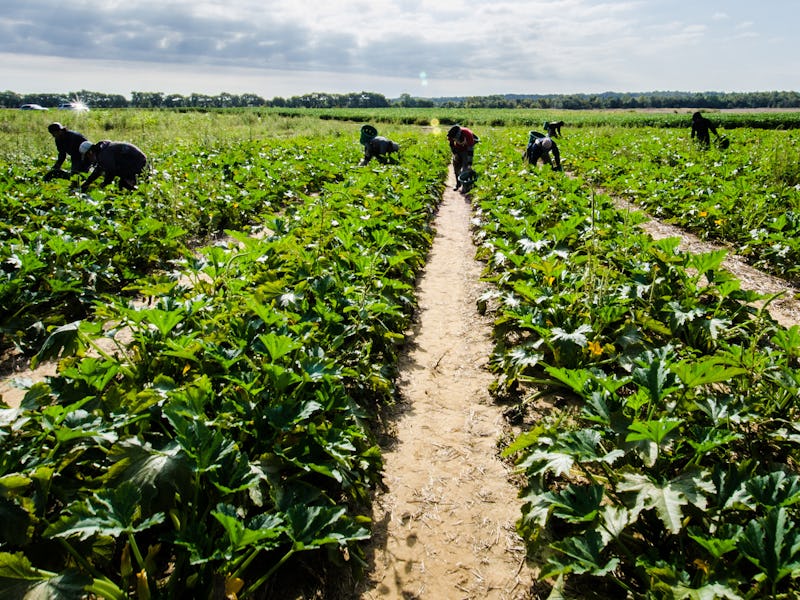There Are 58,000 Slaves in the United States Right Now
Based on an estimation from the Global Slavery Index.

Slavery may be illegal in the United States, but there are still 58,000 working there in conditions that can only be described as such, according to the Global Slavery Index (GSI).
“It’s true that Americans have a hard time imagining slavery that isn’t like an Alabama plantation, but remember that slavery has been around since the very beginning of human history, in many many forms,” said GSI co-author and professor of contemporary slavery Kevin Bales on May 8 in a Reddit AMA. “It never stopped, even when it was made illegal, in the U.S. or anywhere else.”
The Global Slavery Index estimates the prevalence of slavery around the world based on more than 50,000 interviews in 53 different languages. It defines slavery as any kind of forced exploitation, including labor trafficking — seen in domestic work, agriculture, traveling sales crews, restaurant and food service, and health and beauty service — as well as sex trafficking.
Trying to measure the number of slaves in the U.S. is not easy, so any number is just a rough estimate. “We’ve got a real problem trying to get measurements in the U.S., mainly because of the federal system not sharing information,” Bales tells Inverse.
As a result, to come up with a number, the GSI had to compare the U.S. to countries with a similar “risk profile,” namely the UK.
The data that the GSI is able to use in its effort to track slavery in the U.S. tends to be from independent organizations or researchers working at more localized levels. Some of those numbers suggest an even larger problem. For instance, a study by sociologist Sheldon Zhang at San Diego State University in 2012 found that as many as 38,458 victims of labor trafficking violations were reported just in San Diego County and potentially as many as “2,472,000 trafficking victims just among unauthorized Mexican immigrants in the U.S.”
Meanwhile, studies by the Urban Institute show that an underground commercial sex empire thrives in several major U.S. cities.
According to the GSI, some of the most common victims of slavery in America are homeless youth populations and “undocumented workers, migrants, and refugees.” The GSI points to research done on migrant laborer populations in San Diego, California, and in North Carolina, which suggests that for many undocumented laborers, language barriers, cultural non-assimilation, and fear of deportation lead many into slavery.
In his AMA, Kevin Bales also warned against for-profit prisons as a potential form of slavery in the U.S. — though one that is not counted in GSI estimates. “[F]or-profit prisons are very much moving into the zone of State Sponsored Slavery — a distinct type that often includes enslaved prison populations — and used extensively in China,” Bales wrote. So long as due process and a fair justice system remain in effect, U.S. prison populations won’t ever be counted as slaves, but in places like China, long-term prison sentences are often used to bolster a growing workforce in for-profit, state-run prisons.
In terms of sheer numbers of slaves, the United States is ranked 52 out of 167 on the GSI’s assessment. In relative terms, however, the U.S. is at the low-end of the scale with an estimated 0.02 percent of the population in slavery.
The U.S. is, at least, one of the leaders in government response to slavery, according to the GSI, with a rating second only to the Netherlands. The GSI applauds initiatives like President Barack Obama’s Advisory Council on Human Trafficking and says they are setting the stage for continued declines in slavery.
- “[S]lavery may never disappear completely, some people being as they are, but my aim is to see it become as rare as cannibalism,” Bales wrote.
- “[S]lavery may never disappear completely, some people being as they are, but my aim is to see it become as rare as cannibalism,” Bales wrote.The GSI offers the following recommendations for the U.S. to curb slavery:
- Improve the provision of appropriate housing for child trafficking victims.
- Increase screening of at-risk persons for human trafficking.
- Prosecute more cases of labor trafficking.
- Obtain bi-partisan legislative support for the bills to address business supply chain transparency, foreign labor recruiting practices, as well as push for the child welfare system reform.
You can find more information about the Global Slavery Index and the state of slavery in many other countries on the official website.
Must Read: There Are 46 Million Slaves in the World — Here’s Where They’re Found